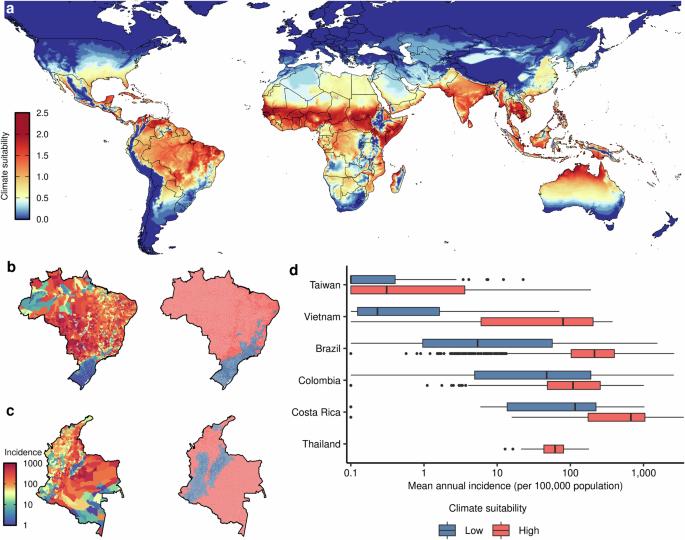Population at risk of dengue virus transmission has increased due to coupled climate factors and population growth
IF 8.1
1区 地球科学
Q1 ENVIRONMENTAL SCIENCES
引用次数: 0
Abstract
Dengue virus transmission has increased over the last four decades seemingly due to changes in climate, urbanization and population growth. Using estimates of dengue transmission suitability based on historical temperature and humidity data, we examined how shifts in these climatic variables and human population growth have contributed to the change in the geographical distribution and size of the global population living in areas with high climate suitability from 1979 to 2022. We found an expansion in climate suitability in North America, East Asia and the Mediterranean basin, where with few exceptions, endemicity is not yet established. Globally, we estimated that the population in areas with high climate suitability has grown by approximately 2.5 billion. In the Global South, this increase was largely driven by population growth in areas with historically favorable climate suitability, while in the Global North this increase predominantly occurred in previously unfavorable areas with limited population growth. Changes in population growth and climatic conditions have increased the risk for dengue transmission, particularly in the Global South, according to a virus transmission index applied to 186 countries from 1979 to 2022.


由于气候因素和人口增长的共同作用,面临登革热病毒传播风险的人口有所增加
在过去的四十年里,登革热病毒的传播似乎因气候的变化、城市化和人口增长而加剧。利用基于历史温度和湿度数据对登革热传播适宜性的估计,我们研究了从 1979 年到 2022 年,这些气候变量的变化和人口增长是如何导致生活在气候适宜性高的地区的全球人口的地理分布和规模发生变化的。我们发现,北美、东亚和地中海盆地的气候适宜性有所扩大,除少数例外情况外,这些地区的地方性尚未确立。从全球来看,我们估计气候适宜性高的地区人口增长了约 25 亿。在全球南部,这一增长主要是由历史上气候适宜性较好地区的人口增长驱动的,而在全球北部,这一增长主要发生在人口增长有限的先前气候不适宜地区。根据从 1979 年到 2022 年适用于 186 个国家的病毒传播指数,人口增长和气候条件的变化增加了登革热传播的风险,尤其是在全球南部。
本文章由计算机程序翻译,如有差异,请以英文原文为准。
求助全文
约1分钟内获得全文
求助全文
来源期刊

Communications Earth & Environment
Earth and Planetary Sciences-General Earth and Planetary Sciences
CiteScore
8.60
自引率
2.50%
发文量
269
审稿时长
26 weeks
期刊介绍:
Communications Earth & Environment is an open access journal from Nature Portfolio publishing high-quality research, reviews and commentary in all areas of the Earth, environmental and planetary sciences. Research papers published by the journal represent significant advances that bring new insight to a specialized area in Earth science, planetary science or environmental science.
Communications Earth & Environment has a 2-year impact factor of 7.9 (2022 Journal Citation Reports®). Articles published in the journal in 2022 were downloaded 1,412,858 times. Median time from submission to the first editorial decision is 8 days.
 求助内容:
求助内容: 应助结果提醒方式:
应助结果提醒方式:


